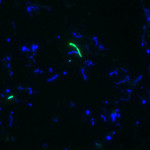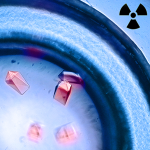A researcher analyzing vast quantities of genomic data is not unlike a beachcomber slowly scanning a beach with a metal detector. Although global microbial populations are orders of magnitude larger than nearly any other population in, on or around the planet, only a fraction has been identified thus far. More thorough surveys could lead to new strategies for DOE researchers to advance their energy and environmental investigations. In a study published January 27, 2016 in Nature Communications, a team led by DOE Joint Genome Institute researchers utilized the largest collection of metagenomic datasets to uncover a completely novel bacterial phylum that they have dubbed “Kryptonia.” Read more on the DOE JGI website.
The Secretary of Energy Advisory Board (SEAB) held a public session at Emery Station
The Secretary of Energy Advisory Board (SEAB) held a public session on Tuesday, January 26 at the Biosciences Area’s Emery Station Operations Center (ESOC). Berkeley Lab’s Director Paul Alivisatos gave a Lab overview. Jennifer Doudna was invited by SEAB to give a briefing of CRISPR-Cas and Ilan Gur led a roundtable discussion on the activities of … Read more »
Simmons Named Division Director for Biological Systems and Engineering
Jay Keasling, Associate Laboratory Director for Biosciences, announced that Blake Simmons has accepted the position of Division Director for Biological Systems and Engineering (BSE) effective February 10, 2016. He will retain his positions as Chief Scientific and Technology Officer and as the Vice President of the Deconstruction Division at the Joint BioEnergy Institute.
A New Pathway for Radionuclide Uptake
Synthetic radionuclides, such as the transuranic actinides plutonium, americium, and curium, present severe health threats as contaminants, and understanding the scope of the biochemical interactions involved in actinide uptake into cells is instrumental in managing human contamination. Recently, scientists have reported that an iron-binding protein called siderocalin can also bind and transport actinides into cells, a major advance in understanding the biological chemistry of radioactive metals. The research, which included X-ray crystallographic studies in the Berkeley Center for Structural Biology (Beamlines 5.0.1 and 5.0.2) at the Advanced Light Source (ALS), opens up new avenues of research into strategies for remedial action in the event of possible human exposure to nuclear contaminants. In addition, siderocalin, the protein studied, was selected as “Molecule of the Month” by the Protein Data Bank’s educational portal. Read more in the ALS Science Highlight.
JBEI Appoints New VP and Deputy VP of Fuels Synthesis Division
The Department of Energy’s Joint Bioenergy Institute (JBEI) Chief Executive Officer, Jay Keasling, has announced that Aindrila Mukhopadhyay will step into the role of Vice President of the Fuels Synthesis Division. This announcement comes after a national search and interview process. Mukhopadhyay, who joined the Lawrence Berkeley National Laboratory (Berkeley Lab) in 2003, will continue to serve as Director of JBEI’s Host Engineering group and as Interim Division Director of Berkeley Lab’s Biological Systems and Engineering (BSE) in the Biosciences Area.
- « Previous Page
- 1
- …
- 198
- 199
- 200
- 201
- 202
- …
- 213
- Next Page »
Was this page useful?







